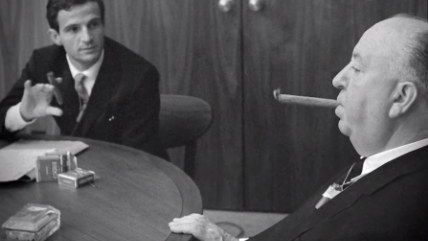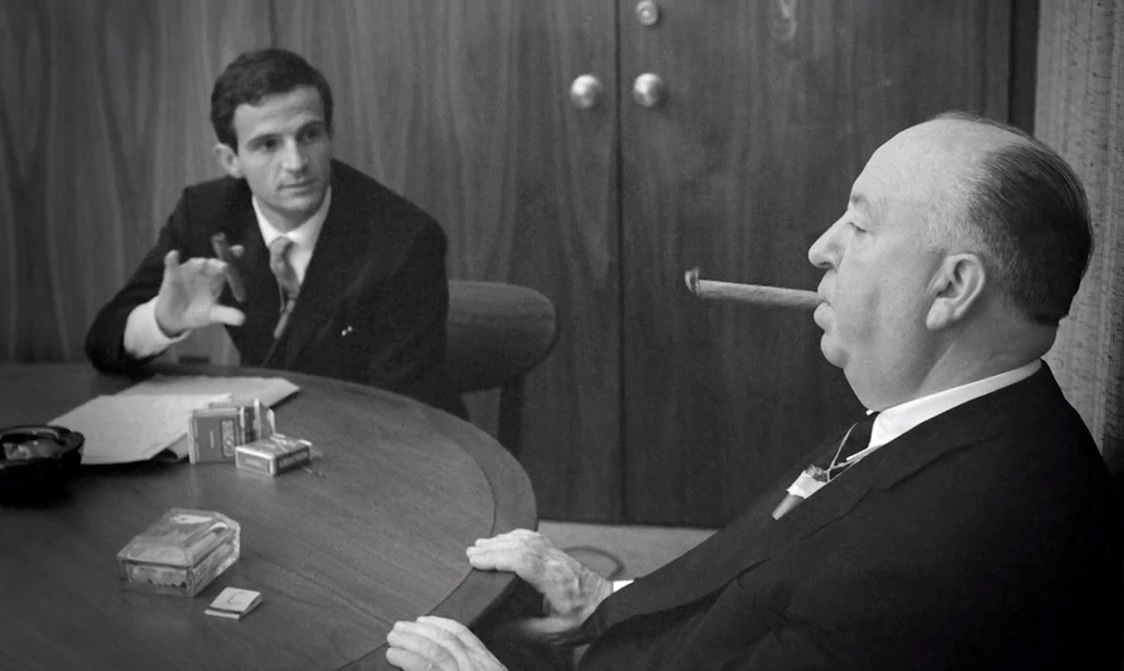Documentary Delves Deeply into Hitchcock's Filmmaker Mind
A critical analysis every film buff should watch


Hitchcock/Truffaut. HBO. Monday, August 8, 9 p.m.
There's a brief scene early in Alfred Hitchcock's 1952 drama I Confess in which Montgomery Clift, playing a priest wrongly suspected of murder, emerges from his church, glances up at a high-rise hotel across the street, then walks away down the sidewalk. But shooting that five seconds of film triggered an argument between the star and the director.
I don't know if I should look at the hotel, brooded Clift. Maybe my character wouldn't do that. Why would he? Maybe he'd look at the people on the street outside the church. Hitchcock's reply was the very antithesis of Method Acting: The priest looks at the hotel because I want the viewers to understand that the hotel is across the street from the church. Now, let's shoot it. Ten years later, speaking to French director Francois Truffaut, Hitchcock could still barely control the anger and contempt in his voice. "An actor is going to interfere with me, organizing my geography?" he exclaimed. "That's why all actors are cattle."
That exchange is a microcosm of what made Hitchcock a great director: His painstaking construction of every scene. His command of the grammar of film. His insistence that he, and not the director of photography or the screenwriter and certainly not the actors, was telling the story.
It is also the reason why, if you're even remotely interested in movies, you should watch Hitchcock/Truffaut, writer-director Kent Jones's superb documentary, which—after a painfully brief and constrained theatrical release last December in a vain attempt to cop an Oscar nomination—gets its first exposure to the public this week on HBO.
It's both based on and an account of the preparation of Truffaut's landmark book Hitchcock, which the documentary correctly labels "one of the few indispensable books on movies."
The book is built around 50 hours of tape-recorded 1962 conversations between Truffaut, then the hottest of the young French New Wave directors, and Hitchcock, who though only a couple of years past the wild box-office success of films like Rear Window and Psycho was being dismissed by American critics as a lowbrow melodramatist and TV hack. (Truffaut decided to do the book after hearing an American critic dismiss Rear Window because it wasn't a realistic portrayal of Greenwich Village.)
Truffaut worked longer and harder on the book than he ever had on a film—It took four years to write—and the result was a remarkable in-depth discussion of dozens of Hitchcock films, often on a shot-by-shot basis. In the 1960s and '70s, it was practically mandatory reading for cinema buffs, many of whom turned into directors. Wes Anderson (The Grand Budapest Hotel, The Royal Tenenbaums), interviewed in Hitchcock/Truffaut, says his copy is so well-used it's "not even a book anymore, it's a stack of papers with a rubber band around it."
Hitchcock/Truffaut is, in part, a multimedia rehash of the book, employing film clips to illustrate points as the two men discuss them. But it's also much more than that, incorporating interviews with directors like Anderson, Martin Scorsese and Peter Bogdanovich to make their own points about Hitchcock.
And Jones has obtained access to at least some of the original tapes of the Hitchcock-Truffaut interviews, which offer revealing and sometimes hilarious expansions of what appeared in the book. Among the most tantalizing is their discussion of the 1958 Vertigo, in which detective James Stewart is obsessively trying to remake his new girlfriend Kim Novak into a carbon copy of one who died.
In the book, Hitchcock said a famous scene in which Stewart waits outside a bathroom door for the remade Novak to emerge wearing the clothes and hairstyle of the other woman had a not-entirely concealed psychological subtext: "What Stewart is really waiting for is the woman to emerge totally naked this time, and ready for love."
But the audio recording in Hitchcock/Truffaut goes a bit further: "While he was looking at that door, he was getting an erection. We will now tell a story—shut the machine off." And, click! Whatever followed is lost to history.
Not every new bit of Hitchcock/Truffaut is so salacious, but they're all fascinating. Though Hitchcock is clearly endeared by Truffaut's love of his films and determination to rehabilitate his reputation, he is not above deflating some of Truffaut's critical conceits. When Truffaut says Vertigo has phantasmagoric elements that could only be informed by Hitchcock's dreams, the British director all but snorts. "A form of necrophila, that's what it really was," he explains.
Mostly, though, Hitchcock/Truffaut is two extraordinarily talented directors talking less about the art of filmmaking than the craft. Hitchcock reveals that in the strangely transfixing scene in 1941's Suspicion in which Cary Grant walks up a darkened staircase with a glass of milk for his paranoid new wife Joan Fontaine (is he trying to poison her?), he drew viewers' eyes to the milk by concealing a small light inside it.
That tightly shot two-and-a-half-minute kiss between Grant and Ingrid Bergman in 1946's Notorious, which continues even as they walk from an apartment balcony through the living room into the kitchen, may have been preposterous, as the unhappy actors told him, but he knew it would work: "I don't care how you feel, I already know what it's going to look like on the screen."
And speaking of preposterous, or at least implausible, yes it does seem unlikely that the airplane buzzing Grant in a flat, open field in North by Northwest would manage to hit a passing gasoline truck, the only thing over three feet tall for miles around. "But you see, to me, plausibility for the sake of plausibility doesn't help," shrugs Hitchcock. "I have a little saying to myself: Logic is dull." Hitchcock/Truffaut never is.


Show Comments (25)